Vintage children's furniture for learning in style
Back to School
Stepping out in the morning to feel the fresh, September air, for me, will forever be associated with the first days of school. All over the world around this time, lucky children are returning for another year of inspiration, edification, and maybe a bit of playground rough-and-tumble.
The details we remember from our childhood—fragments of shapes, textures, smells, and sounds—often seem arbitrary. But these memories form an enduring foundation for who we become, thanks to the temporal lobe logging our long-term memories. Hello, biology class!
In 2016, child-focused furniture dominated Milan Design Week, and the market has continued to blossom. Which is great news, since children’s toys and furniture are cultural artifacts that affect early development. And when vintage pieces are in the home, children cultivate a sense of care and longevity and maybe even a touch of sustainability. With these #homegoals in mind, let’s take a look at some vintage pieces that engender stimulating learning environments and are very much worth remembering. (Recognize any of these?)
Desks for Concentration
Desks are where the magic happens, from A+ book reports to secret notes to BFFs; they should promote maximum concentration facilitated by storage space for pens, notebooks, and bubblegum. These timeless classics are like functional works of art, featuring innovative production techniques and attention to formal detail.
The Space Age Desk on the left was designed in 1970 by Luigi Colani and made in Germany by Flötotto. The height-adjustable desk is intended to grow with young people but is also suitable for adults. The rare, tubular steel Children’s Desk in the middle was designed by Belgian designer Willy Van der Meeren for Tubax in the 1950s. Model 800 School Desk on the right was designed in 1952 by French master Jean Prouvé for Atelier Prouvé, his Nancy-based manufactory that produced sturdy, modernist furniture for mid-century French schools and workspaces. .
Chairs for Ergonomics and Posture
Given that we do so much sitting these days, it’s important to choose seats designed with ergonomics and posture in mind. These vintage gems are lightweight, easy to move, and biomorphic—not to mention full of personality!
The charming Pantoflex Mickey Mouse Chair on the left was designed by design legend Verner Panton for German manufacturer VS Vereinigte Spezialmöbelfabriken in the 1990s. The Space Age polypropylene Casalino Children's Chair in the middle was designed by Alexander Begge and produced in the Netherlands in the 1970s by Casala, which celebrated its 100th Anniversary last year. The molded Plywood Children’s Chair on the right hails from Toy Labs, a classic midcentury modern manufacturer in Grand Rapids, Michigan. It's durable and provides good back support—and thanks to the handle, it's readily portable for when you want to move to sit next to your pals.
Creative Play Beyond Screen Time
After an arduous day of learning at school, it's time to invite some pals over to hang out. Maybe a board game? Arts and crafts? A spot of tea? These children’s table-and-chair sets will amplify the magical atmosphere for whatever kids can dream up.
The 1950s French Children's Rattan Set on the left is perfect for sharing a cold pitcher of homemade lemonade with a playground friend in the garden. The red-painted Anna Children's Set in the middle was designed by Karin Mobring for Ikea in the 1980s—featuring adjustable seats for friends big and small. The easy-to-clean, bright orange Poly Bel Twen Collection on the right was designed by the Beltzig brothers in 1967 for German manufacturer Brüder Beltzig Design.
Physical Play to Get Active
Tea parties are lovely, but kids also need to move their bodies. Physical activity develops fine and large motor skills and hand-eye coordination. Plus, it’s super fun! Step away from the screens, and try some of these retro-play activities!
The vividly painted plywood Vintage Seesaw on the left offers classic fun in an uber-cool, Bauhausian form. There's also this Beech Rocking Horse by Kay Bojesen , on th right, an icon of Scandinavian modernism produced in Denmark. Or tool around with the wind in your hair on this 1950s Red Toy Pedal Car, in the middle. Vrooooooom!
Imaginative Play to Build Creative Thinking
As the days get shorter, imaginative play moves indoors. Pretending is an ideal way to strengthen emotional development, social bonds, and creative problem solving. Travel back in time with these pretend-play finds from a slower, more low-fi era.
Designed in the 1960s by Swedish brand Briohis, this Vintage Toy Truck on the left features an old-timey steering wheel reflector on the back. Who’s driving the truck, you may ask? What about these Tivoli Guard Figures, on the right, designed by Kay Bojesen in the 1950s? Waving at them as they pass is this Barum Rubber Man, in the middle, by Czech designer Libuše Niklová for Fatra Napajedlá from the 1950s.
-
Text by
-
Emma Lucek
A British-born Pole currently based in Berlin, Emma has a background in research and design. In addition to being Pamono's Design Editor, lately she's been working on critical writing in the fields of art, architecture, and cultural theory, as well as design journalism.
-
More to Love
Vintage Children's Chair

Children's Chair by Erwin Egel for Nürnberg-Moorenbrunn, Dieter Güllert, 1967

Vintage Child's Chair by Luigi Colani for Top System, 1972
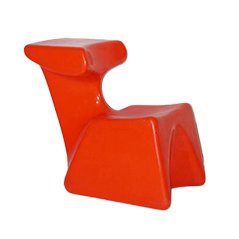
Adjustable Desk by Luigi Colani for Flötotto, 1970s

Red School Desk with Chair, 1950s

Mid-Century Industrial Children's Table by Willy Van Der Meeren
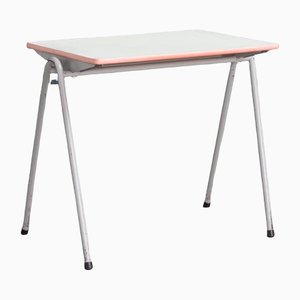
Mid-Century Children's Desk

Yellow Casalino Children's Chairs by Alexander Begge for Casala, 1970s, Set of 2
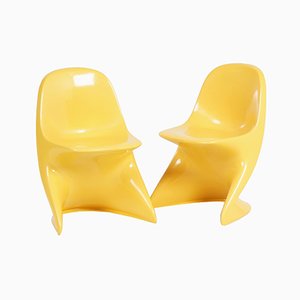
Vintage Children's School Desk and Chairs Set by Willy van der Meeren for Tubax

Red Toy Pedal Car for Children, 1950s
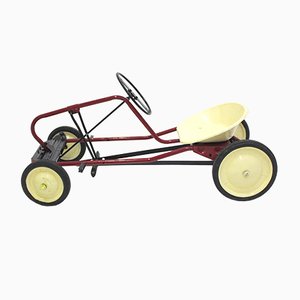
Children's Rattan Lounge Set, 1950s
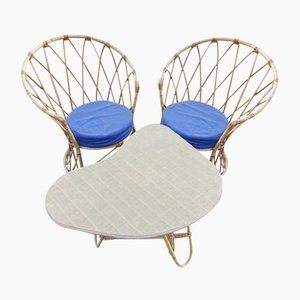
Children's Barber Seat, 1950s







